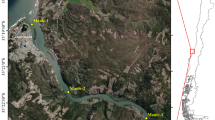Abstract
The diatom Didymosphenia geminata has been reported in literature as a species of cold and oligotrophic waters. In the 1960s it was found in small quantities in southern Poland in oligotrophic, submontane and mountane waters, but was not found there in the years immediately afterwards. However, in the 1990s it unexpectedly appeared in the Carpathian tributaries of the River Vistula, which are mostly mesotrophic in character. In the River San it formed masses below the Solina and Myczkowce reservoirs, where changes in the trophic state had been observed for some years. It is concluded that D. geminata has a wider capacity for adaptation than has previously been assumed. Either the material in the R. San is a different ecotype or the underlying factors favouring the species are rather different from those assumed previously.
Similar content being viewed by others
References
Antoine, S. E. & K. Benson-Evans, 1984. Morphological variation in six populations of Didymosphenia geminata (Lyngbye) M. Schmidt of Great Britain. Nova Hedwigia 40: 141-156.
Bombówna, M., 1991. Chemizm wód powierzchniowych, In Dynowska, I. & M. Maciejewski (eds), Dorzecze Górnej Wis?y, Warszawa-Kraków, PWN: 11-26.
Bucka, H., 2002. Upper Vistula River: Response of aquatic communities to pollution and impoundment VI. Net phytoseston communities. In ?urek, R. & H. Kasza (eds), Polish J. Ecol. 50(2): 167-189.
Cleve-Euler, A., 1955. Die Diatomeen von Schweden und Finnland. Handl. K. svenska Vetensk. Akad., Fjärde Ser. 5(4): 1-232.
Hofmann, G., 1994. Aufwuchs-Diatomeen in Seen und ihre Eignung als Indikatoren der Trophie. Bibliotheca Diatomologica, 30, J. Cramer, Berlin, Stuttgart: 241 pp.
Johansson, C., 1980. Attached algae vegetation in some streams from the Narssaq area South Greenland. Acta Phytogeogr. Suecica 68: 89-96.
Kasza, H. & J. Galas, 2001. Upper Vistula River: Response of aquatic communities to pollution and impoundment. II. Chemical composition of water and sediment. In ?urek, R. & H. Kasza (eds), Polish J. Ecol. 50, 2: 123-135.
Kawecka, B., 1965. Communities of benthic algae in the River Bia?ka and its Tatra tributaries the Rybi Potok and Roztoka. Komitet Zagosp. Ziem Górskich PAN, 11: 113-129.
Kawecka, B., 1980. Sessile algae in European mountain streams. 1. The ecological characteristics of communities. Acta Hydrobiol. 22: 361-420.
Kawecka, B. & P. Eloranta, 1987. Communities of sessile algae in some small streams of Central Finnland. Comparision of the algae of the high mountains of Europe and those of its nothern regions. Acta Hydrobiol. 29: 403-415.
Komulaynen, S. F., 1996. Perifiton Rek Leningradskoj, Murmanskoj Oblastej I Respubliki Kareliâ [Periphyton of Leningrad, Murmansk districts and Republic of Karelia], Rossijskaâ Akademiâ Nauk, Karelskij Nau?nyj Centr, Petrozavodsk [Russian Academy of Sciences, Karelian Center of Sciences, Petrozawodzk]. 39 pp.
Krammer, K. & H. Lange-Bertalot, 1986-1991a,b. Bacillariophyceae. Süsswasserflora von Mitteleuropa. 2 (1-4), VEB G. Fischer Verlag, Jena.
Metzeltin, D. & H. Lange-Bertalot, 1995. Kritische Wertung der Taxa Didymosphenia (Bacillariophyceae). Nova Hedwigia 60: 381-405.
Mrozi?ska, T. & J. Czerwik, 1996. Glony na terenach przysz?ych zbiorników wodnych w Dolinie Dunajca (Czorsztyn-Niedzica i Sromowce Wy?zne). XV Symp. Fykol. PTB, Lublin-Krasnobród-Zwierzyniec, 10-12 maja 1996: 31
Pasternak, K., 1964. Geologiczna i gleboznawcza charakterystyka dorzecza rzeki Sanu - Geological and pedological characteristics of the basin of river San. Acta Hydrobiol. 6: 289-307.
P?u?a?ski, A., T. Pó?torak, J. Tomaszek, M. Granops, R. ?urek & E. Dumnicka, 1990. Charakterystyka limnologiczna zbiorników kaskady górnego Sanu (Solina, Myczkowce). In Kajak, Z. (ed.), Funkcjonowanie ekosystemów wodnych ich ochrona i rekultywacja, cz.I. Ekologia zbiorników zaporowych i rzek. CPBP 04.10, SGGW- AR Warszawa: 264-281. (Functioning of Aquatic Ecoystems. Their Protection and Reclamation, Part 1. The Ecology of Impoundments and Rivers.)
Rakowska, B. & M. Bie?, 2000. Okrzemki bentosowe rzeki San na stanowisku w Posto?owie ko?o Sanoka, ze szczególnym uwzgl¸ednieniem okrzemki Didymosphenia geminata (Lyngbye) M. Schmidt. Uniwersytet ?odzki, Katedra Botaniki (manuscript) (Benthic diatoms in the River San at station Posto?ów near Sanok with special consideration for the diatom Didymosphenia geminata (Lyngbye) M. Schmidt)
Sanecki, J., 1991. Zbiorowiska glonów osiad?ych w Dunajcu w jego górnym biegu i w rejonie zbiorników zaporowych, Dissertation, Jagiellonian University in Kraków: 127 pp.
Sanecki, J., E. Dumnicka, & J. Starmach, 1998. Charakterystyka podstawowych elementów biocenoz Dunajca i jego dop?ywów w rejonie nowopowsta?ych zbiorników zaporowych. (Characteristics of basic biocenoses of River Dunajec and its tributaries in the area of newly built dam reservoirs, Pieniny-Przyroda i Cz?owiek 6: 89-99 (Polish, with English summmary)
Siemi?ska, J., 1964. Chrysophyta 2, Bacillariophyceae - Okrzemki, Starmach K. (ed.), Flora S?odkowodna Polski, 6, PWN, Warszawa: 609 pp.
Skulberg, O.M. & A. Lillehammer, 1984. Glåma. InWhitton, B. A. (ed.), Ecology of European Rivers. Blackwell Sci. Publs, Oxford, Melbourne: 469-498.
Sláde?ek, V., 1973. System of water quality from the biological point of view. Arch. Hydrobiol. Beih./Ergebn. Limnol. 7: 218 pp.
Sláde?ek, V., 1986. Diatoms as indicators of organic pollution. Acta Hydrochim. Hydrobiol. 14, 5: 555-566.
Van Dam, H., A. Mertens, & J. Sinkeldam, 1994. A coded checklist and ecological indicator values of freshwater diatoms from theNetherlands. Neth. J. Aquatic Ecol. 28: 117-133.
WIO?-Jas?o, 1996. Raport o stanie ?rodowiska w Województwie Podkarpackim. (The State of the Environment, report in Subcarpathian Voivodeship).
WIO?-Kraków, 2000. Raport o stanie ?rodowiska w Województwie Krakowskim (The State of the Environment, report in Kraków Voivodeship).
Author information
Authors and Affiliations
Corresponding author
Rights and permissions
About this article
Cite this article
Kawecka, B., Sanecki, J. Didymosphenia geminata in running waters of southern Poland – symptoms of change in water quality?. Hydrobiologia 495, 193–201 (2003). https://doi.org/10.1023/A:1025469500265
Issue Date:
DOI: https://doi.org/10.1023/A:1025469500265




